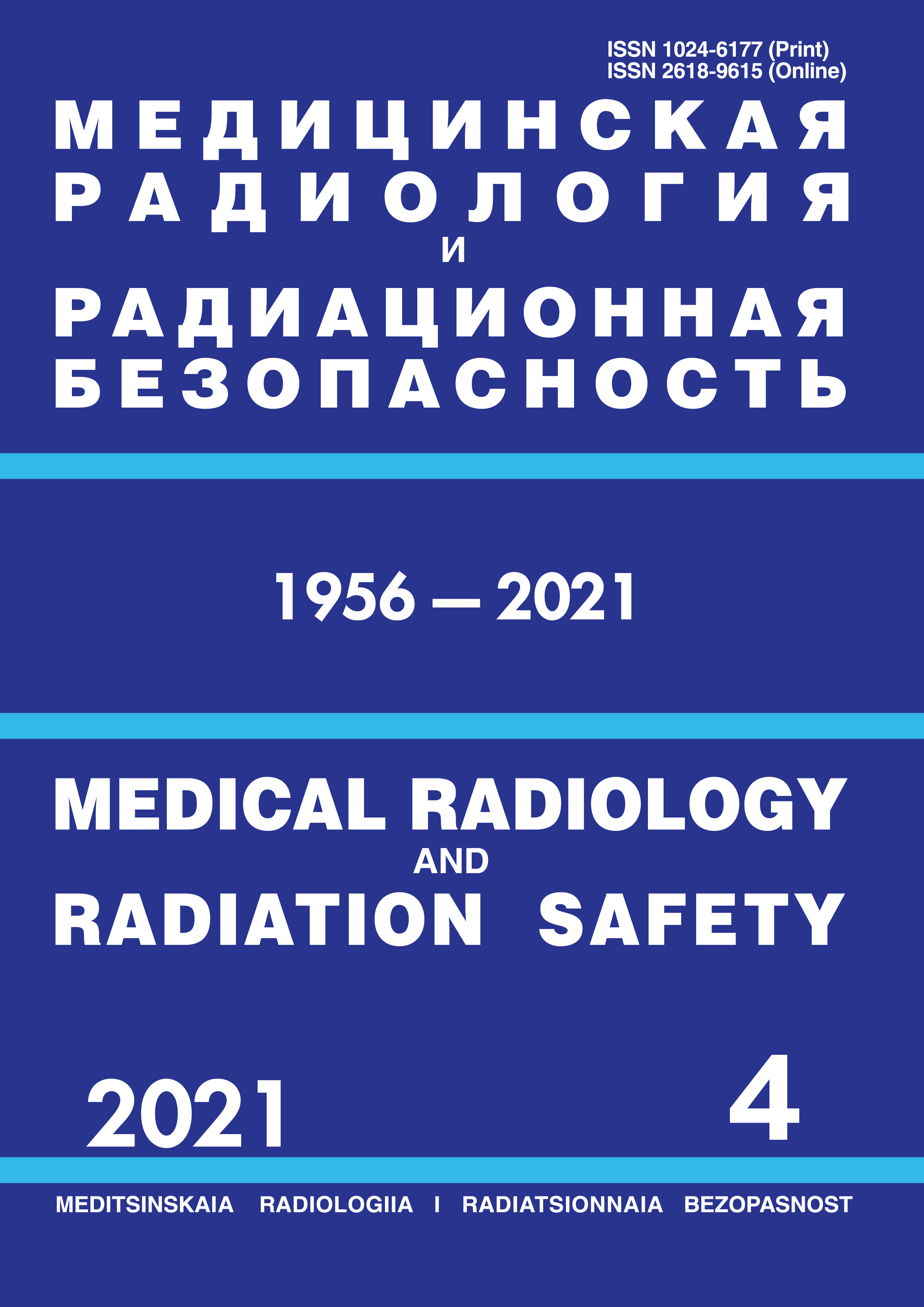Russian Federation
CSCSTI 76.33
CSCSTI 76.03
Russian Classification of Professions by Education 31.06.2001
Russian Classification of Professions by Education 31.08.08
Russian Classification of Professions by Education 32.08.12
Russian Classification of Professions by Education 14.04.02
Russian Library and Bibliographic Classification 534
Russian Library and Bibliographic Classification 51
Russian Trade and Bibliographic Classification 5712
Russian Trade and Bibliographic Classification 5734
Russian Trade and Bibliographic Classification 6212
Russian Trade and Bibliographic Classification 5708
Purpose: Comparative assessment of radiation-induced changes in neurons of the cerebral cortex after a single and fractionated exposure to ionizing radiation in doses of 0.1 – 1.0 Gy. Material and methods. The study was carried out in compliance with the rules of bioethics on 180 white outbred male rats at the age of 4 months. by the beginning of the experiment, exposed to a single or fractionated exposure to γ-quanta of 60Co in total doses of 0.1; 0.2; 0.5 and 1.0 Gy. Neuromorphological and histochemical methods were used to assess morphometric and tinctorial parameters of nerve cells, as well as changes in the content of protein and nucleic acids in neurons in the early and late periods of the post-radiation period. Using one-way analysis of variance, a comparative assessment of neuromorphological indicators under various modes of radiation exposure is given. Results: In the control and irradiated animals throughout their life, undulating changes in the indicators of the state of the neurons of the brain occur with a gradual decrease by the end of the experiment. Despite a number of features of the dynamics of neuromorphological parameters, these irradiation regimes do not cause functionally significant changes in the neurons of the cortex. However, in some periods of the post-radiation period, the changes under the studied irradiation regimes were multidirectional and did not always correspond to age control. Significant differences in the response of neurons to these modes of radiation exposure in the sensory and motor areas of the cerebral cortex have not been established. Conclusion: No functionally significant radiation-induced changes in neurons were found either with single or fractionated irradiation. At the same time, different modes of irradiation in general caused the same type of changes in neurons. However, in some periods of observation, changes in neuromorphological parameters under the studied irradiation regimes were not unidirectional and differed from age control, which indicates a possible risk of disturbances in the functioning of the nervous system against the background of other harmful and dangerous factors.
low doses of radiation, irradiation, brain, changes in neurons, rats
1. Gus'kova A.K. Radiaciya i mozg cheloveka. // Medicinskaya radiologiya i radiacionnaya bezopasnost'. 2001. T. 46, № 5. S. 47-55.
2. Legeza V.I., Reznik V.M., Pimburskiy V.F. K voprosu ob osobennostyah mnogoletney dinamiki urovney bolezney sistemy krovoobrascheniya u voennosluzhaschih-likvidatorov posledstviy avarii na Chernobyl'skoy AES. // Med.-biol. i soc.-psihol. probl. bezopasnosti v chrezv. situaciyah. 2016. T.1, S. 34-40.
3. Nikiforov A.M., Aleksanin S.S., Chugunova L.N. Osobennosti psihologicheskogo statusa i mediko-psihologicheskaya reabilitaciya uchastnikov avariyno-vosstanovitel'nyh rabot na ChAES. // Medicinskaya radiologiya i radiacionnaya bezopasnost'. 2002. T. 47, № 5. S. 43-50.
4. Torubarov F.S., Kuleshova M.V., Luk'yanova S.N., Zvereva Z.V. Spektral'no-korrelyacionnyy analiz EEG u likvidatorov avarii na ChAES s nevrologicheskimi narusheniyami. // Medicinskaya radiologiya i radiacionnaya bezopasnost'. 2019. T. 64, №. 3. S. 40-45.
5. Ushakov I.B., Fedorov V.P., Gundarova O.P. Neyromorfologicheskie korrelyaty malyh radiacionnyh vozdeystviy. // Med.-biol. i soc.-psihol. probl. bezopasnosti v chrezv. situaciyah. 2016. № 1. S. 71-78.
6. Shamrey V.K., Chistyakova E.I., Matyschina E.N. i dr. Radiacionnaya psihosomaticheskaya bolezn' u likvidatorov posledstviy avarii na Chernobyl'skoy AES. // Med.-biol. i soc.-psihol. probl. bezopasnosti v chrezv. situaciyah. 2016. № 1. S. 21-33.
7. Fedorov V.P., Ushakov I.B., Fedorov N.V. Cerebral'nye effekty u likvidatorov Chernobyl'skoy avarii. Saarbryukken: LAP LAMBERT Academic Publishing, 2016. 390 s.
8. Aleksanin S.S. Patogeneticheskie zakono¬mernosti formirovaniya somaticheskoy patologii posle radiacionnyh avariy v otdalennom periode // Vestn. Ros. Voen.-Med. Akad. 2008. T. 23, № 3. S. 10-13.
9. Buzunov V.A. Osnovnye itogi i zadachi epidemiologicheskih issledovaniy medicinskih posledstviy avarii na Chernobyl'skoy AES (rezul'taty 4-letn. nablyudeniy) // Vestn. AMN SSSR. 1991. №. 11. S. 36-39.
10. Ushakov I.B., Fedorov V.P. Malye radiacionnye vozdeystviya i mozg. Voronezh: Nauchnaya kniga, 2015, 536 c.
11. Ushakov I.B., Fedorov V.P. Neyromorfologicheskie korrelyaty prolongirovannyh radiaci¬onnyh vozdeystviy. // Med.-biol. i soc.-psihol. probl. bezopasnosti v chrezv. situaciyah. 2018. №. 3. S. 86-97.
12. Ushakov I.B., Fedorov V.P., Sgibneva N.V. Neyromorfologicheskie korrelyaty moschnosti dozy radiacionnogo vozdeystviya. // Med.-biol. i soc.-psihol. probl. bezopasnosti v chrezv. situaciyah. 2019. №. 4. S. 59-69.
13. Sgibneva N.V., Fedorov V.P. Morfofunkcional'noe sostoyanie sensomotornoy kory posle malyh radiacionnyh vozdeystviy. Voronezh: Nauch. kniga, 2013. 256 c.
14. Sgibneva N.V., Fedorov V.P., Gundarova O.P., Maslov N.V. Plastichnost' neyronov sensomotornoy kory v usloviyah povyshennogo radiacionnogo fona. // Medicinskaya radiologiya i radiacionnaya bezopasnost'. 2017. T. 61. № 1. S.20-26.
15. Fedorov V.P., Petrov A.V., Stepanyan N.A. Ekologicheskaya neyromorfologiya. Klassifikaciya tipovyh form morfologicheskoy izmenchivosti CNS pri deystvii antropogennyh faktorov. // Zhurnal teoreticheskoy i prakticheskoy mediciny. 2003. № 1. S. 62-66.





